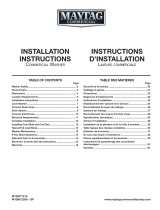
10
NOTE: After the washer has been installed and plugged in, the
display may show ‘0 MINUTES’. Once the washer has been
plugged in and the washer door opened and closed, the display
will show the price. In washers set for free cycles, the display will
flash ‘SELECT CYCLE’.
1. Insert coins until ‘SELECT CYCLE’ flashes in display.
2. Door must be closed before cycle selection is made,
3. Press fabric setting button for the wash cycle desired. After
the cycle is started, the time will display and count down.
4. If a cycle is interrupted by opening the door, ‘RESELECT
CYCLE’ will flash in the display. To restart the washer, close
door, and reselect desired cycle.
General User Information
SCROLLING ‘OUT OF ORDER’ SHOWING IN DISPLAY
This condition indicates the washer is inoperative.
‘0 MINUTES’ SHOWING IN DISPLAY
This indicates the cycle is complete and the washer cannot be
operated. Coins dropped or debit inputs during this condition will
be stored in escrow but cannot be used until normal operation is
restored by opening and closing the door. If a door switch fails, it
must be replaced before normal operation can be restored.
COLD START (Initial first use)
Washer is programmed at the factory as follows:
11-minute wash period
3 rinses (extra rinse not enabled)
$2.00 wash price (9050 model)
$0 wash price (9060 model)
WARM START (after power failure)
A few seconds after power is restored, if a cycle was in progress at
the time of the power failure, ‘RESELECT CYCLE’ will flash in the
display, indicating the need for a key press to restart the washer.
DOOR LOCK
Prior to beginning a cycle, there is a door lock routine of lock/
unlock/relock; then cycle begins. The door will remain locked
until the end of a cycle or approximately 2 minutes after a
power interruption.
PRICING
After the door is opened following the completion of a cycle, the
display indicates the cycle price (unless set for free operation). As
coins are dropped or debit inputs arrive, the display will change to
lead the user through the initiation of a cycle.
FREE CYCLES
This is established by setting the cycle price to zero. When this
happens, ‘SELECT CYCLE’ will appear rather than a cycle price.
DEBIT CARD READY
This washer is debit card ‘cable’ ready. It will accept a variety of
debit card systems, but does NOT come with a debit card reader.
Refer to the debit card reader manufacturer for proper washer
set-up. In models converted to a Generation 1 debit card system,
debit pulses represent the equivalent of one coin (coin 1).
Control Set-up Procedures
IMPORTANT: Read all instructions before operating.
9050 Models: Insert access door key, turn, and lift to remove
access door.
9060 Models: Once the debit card reader is installed (according
to the reader manufacturer’s instructions), the set-up mode can
only be entered by inserting a set-up card (supplied by the reader
manufacturer) into the card slot. If a set-up card is not available,
diagnostic modes can be entered by removing connector AA1 on
the circuit board or by using the Service Access Code (see Service
Access Code section, page 12) for 9060 models.
IMPORTANT: Unplug washer or disconnect power before opening
the console. To access connector AA1:
1. Unplug washer or disconnect power.
2. Open console, disconnect plug on AA1, close console.
3. Plug in washer or reconnect power.
The washer is now in the set-up mode. The lower 3 buttons and
the digital display are used to set up the controls. The display
can contain 4 numbers and/or letters and a decimal point. These
are used to indicate the set-up codes and related code values
available for use in programming the washer.
Once the washer has been programmed with a Gen 2 card reader
installed, the washer will be in dAS mode permanently, and dAS
will be displayed every time set-up mode is accessed.
The lower fabric setting buttons and the digital display are used to
set up the controls.
The display can contain 4 numbers and/or letters and a decimal
point. These are used to indicate the set-up codes and related
code values available for use in programming the washer.
HOW TO USE THE BUTTONS TO PROGRAM THE CONTROLS
1. The HOT button is used to adjust the values associated with
set-up codes. Pressing the button will change the value by
increments. Rapid adjustment is possible by holding down
the button.
2. The WARM button will advance through the set-up codes.
Pressing the button will advance to the next available set-up
code. Holding the button down will automatically advance
through the set-up codes at a rate of 1 per second.
3. The COLD button is used to select or deselect options.
USER & SETUP INSTRUCTIONS




















